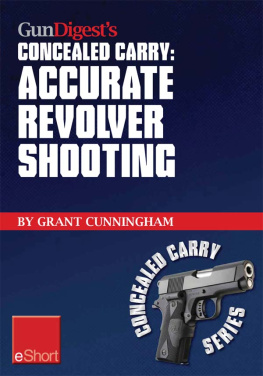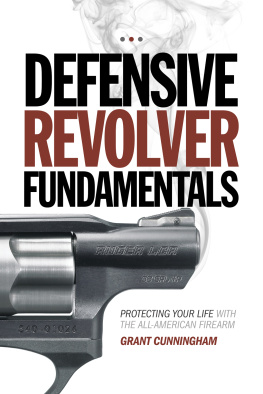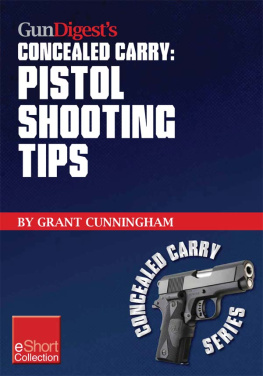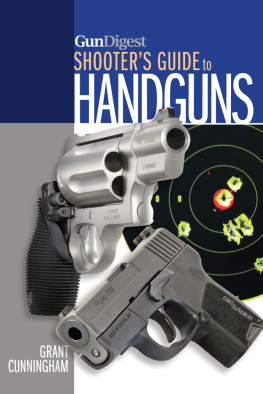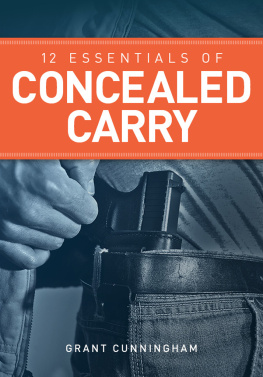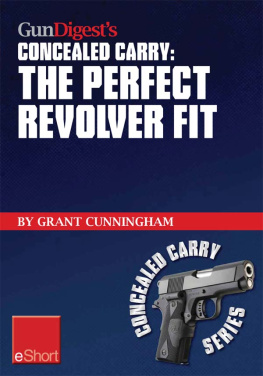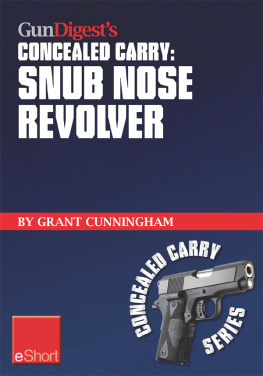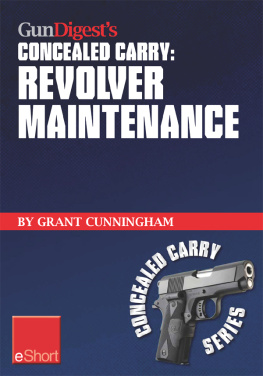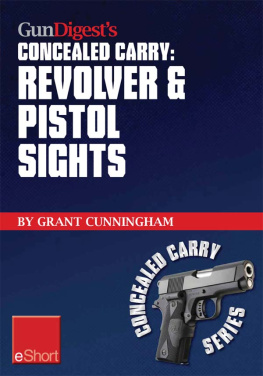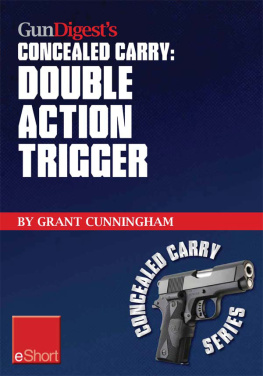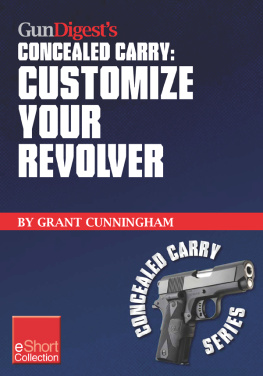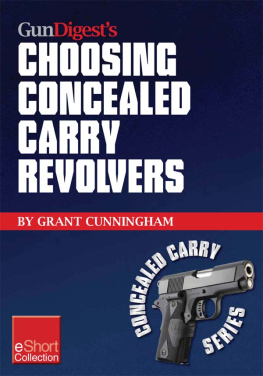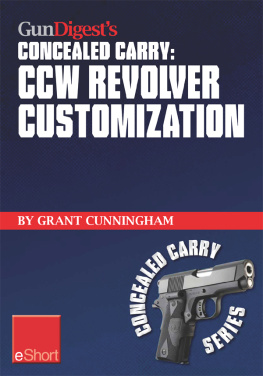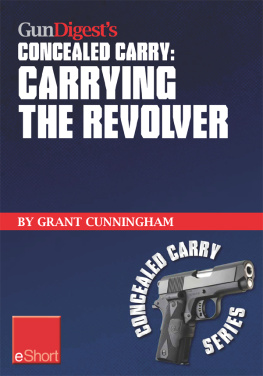Strong, mechanically efficient grasp is key to good double action shooting. Shooting a double action revolver accurately really isnt all that difficult, once you know how to do it and give it some directed practice. In this chapter were going to put together what weve learned about sight picture/alignment and trigger control to make accurate double action shooting easier.
Start with a good foundation By now you should understand that trigger control is the most important part of shooting the revolver. Sight alignment and picture are relatively easy and dont really require much practice; once you know what a proper sight picture is, you have it. It requires no physical practice to remember. Poor trigger control, on the other hand, will destroy even the most precise sight picture.
If the gun wanders off target during either compression or reset, the deviation of your bullets will increase. (Thats a polite way of saying that you wont hit what youre aiming at!) Its trigger control that makes the difference between hoping you hit your target and knowing that you can hit it. Before proceeding, make sure that youve read and understand the preceding chapter on mastering the double action trigger. Its important that you be able to manipulate the heavy, long trigger without moving the gun around. If you cant, do some targeted dry fire. (Dry fire isnt an activity that can be done while you watch television. (Dry fire isnt an activity that can be done while you watch television.
To do it right, to get any real lasting benefit, you have to concentrate on the act and pay attention to what youre doing. Done this way, it takes very few dry fire repetitions to cement the skill. Done with watching the distraction of Spongebob Squarepants, it might take years. Its your choice.) Start from the top: a solid grasp is essential to double action shooting. Remember that you have a trigger that is at minimum four times what the gun weighs, and the only way to keep the force applied to the trigger from moving the gun is a strong grasp. How strong? I coach my students to grasp the gun as tightly as they possibly can, until the gun starts to shake from muscle tremors, then back off the pressure just enough to stop the trembling.
The resulting grasp should feel extremely solid, as if the gun and your hands were carved out of a single piece of granite. I suggest applying equal pressure with both hands. There are those who suggest that the support hand apply more pressure than the shooting hand, but this leads to an inconsistency when shooting one-handed. If youre accustomed to the shooting hand having less pressure, youll have to dramatically increase the pressure to shoot one-handed effectively. In essence, youre learning two different grasps. Keep things consistent, apply the same pressure with both hands, and whether youre shooting with both or only one youll have a predictable hold on the gun.
Compress and release the trigger without steering the gun in any direction. Pay attention particularly to the smooth, predictable release. You should be able to do several dry fired trigger strokes without moving the sights off alignment with the target. Once those things have been accomplished, its time for live fire. But there is still a psychological barrier to be crossed, one which trips up a lot of people (your author included): attempting to get just the perfect sight alignment before hurriedly stroking the trigger.
How to hit the four-inch center of a Bianchi target? Let your sights wander, as long as they stay inside that circle.Moving point of aim There is a concept which has been around a while and is applicable to all kinds of shooting, but unfortunately doesnt seem to be well understood by all that many people including a lot of instructors Ive spoken to.
How to hit the four-inch center of a Bianchi target? Let your sights wander, as long as they stay inside that circle.Moving point of aim There is a concept which has been around a while and is applicable to all kinds of shooting, but unfortunately doesnt seem to be well understood by all that many people including a lot of instructors Ive spoken to.
It was explained to me years ago by ace instructor Georges Rahbani, and at the point that I finally understood its value my shooting took a big stride forward. Ive made use of it ever since, and Ive watched it work wonders both with his students and my own. Its called moving point of aim. It starts with the understanding that very few people, if any, can stick a handgun out in front of their body and hold it perfectly steady. There is always some movement of the muzzle with respect to the target, and the longer one is holding the gun the more movement there will be. Its visible by use of the sighting system, and it is inevitable.
The shooter sees that the muzzle is always moving, and tries to hold it steady on target just long enough to grab the shot when the sights hit the perfect spot. Because the gun is already moving and because the sudden contraction of the hand muscles tends to pull it off target, this usually results in the shot being thrown wildly off target. (Again, why I dont like the term trigger pull!) Some people call this snatching the trigger or grabbing the shot, and its very common. If youre trying to shoot accurately in double action but find a percentage of your shots hitting low and/or to the right (to the left if youre a southpaw), youre probably doing this. Many times instructors will diagnose a flinch when in reality the problem is trying to grab the shot. The longer the shooter waits while attempting the shot, the worse the grab tends to be.
Its a psychological issue, not really a physical one. There is the desire to make the shot, and the brain seeing the sights coming up to the aim point on the target says NOW! Come on, you schmuck, PULL that trigger NOW! Hurry, hurry, HURRY! The shooter obliges, and the shot is off the point of aim sometimes radically so. Moving point of aim (MPA) gets us past that block. First, we acknowledge that were not going to hold the gun perfectly steady on a spot. Second, we understand that even if the gun is moving, as long as its moving inside of the target area we want to hit, well hit it. Lets say that the target is a standard 8-1/2x11-inch sheet of copier paper, and any hit on that target is equal to any other hit.
Stand 10 yards away and align your gun on that target. You can watch your sights wobble a bit, but lets be even more generous let your sights wander all over that sheet of paper, but not off of it. Thats a huge amount of movement, and controlling it is well within the capabilities of just about anyone. As long as you stroke the trigger smoothly back, without imparting any further movement to the gun, no matter where your sights are on the target youll hit it. As long as your sights are somewhere, anywhere, on that piece of paper when the shot breaks, youre going get a hit on target. Its really that simple! It makes perfect sense.
If the guns wobble zone is within the confines of the target and you can stroke the trigger without moving the gun, without steering it in any way, your shots cannot go anywhere but on the target. The key is watching the gun move as the trigger is smoothly stroked, paying more attention to the movement than to the trigger. Exactly when the shot breaks doesnt matter, because the sights are always on target. The importance of the smooth trigger stroke in this process should not be overlooked. Shooting well with a revolver really isnt a matter of the perfect sight picture, its a matter of smooth trigger control. As this little experiment shows, the sights can be a surprisingly long way off and the shots will still hit the target, as long as the gun isnt being thrown off target by an untrained trigger finger.

